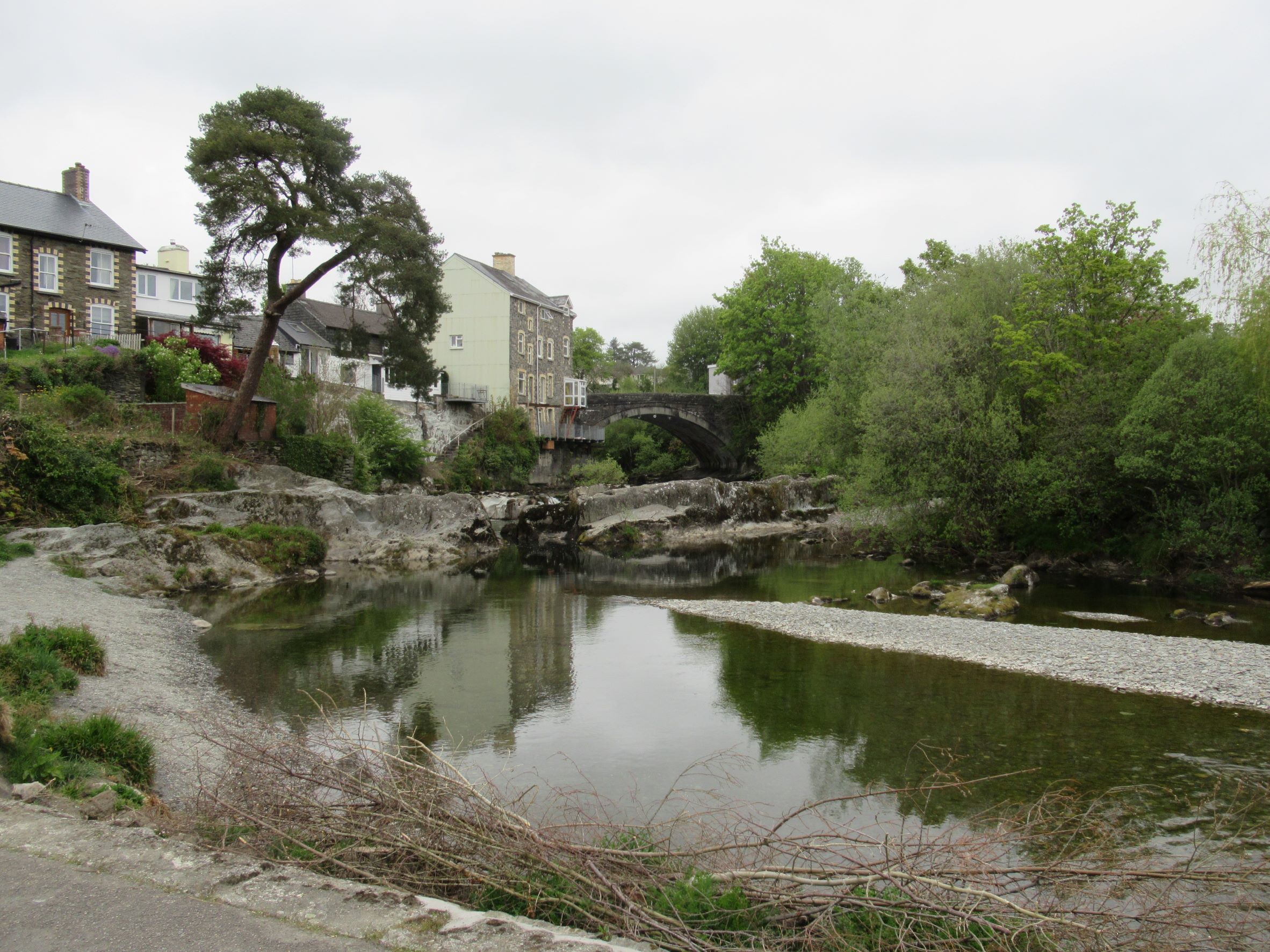We’ve been given a short stretch today after yesterday’s labours. The owner of the guest house waves us off. We’re too late to see the otters, he says, but we might consider a dip in Plum Tree Pool, a few miles upriver. Luckily I’ve left my swimming trunks behind. The sky has heavier clouds than yesterday, and rain is forecast later, so we set off across the Groe – the guest house is on the half way line of the rugby pitch – and along a fine avenue of trees leading up the river and out of the town. This is classic dog walker territory, and outside Builth a bouncy lurcher takes a too-active interest in C. But after a couple of miles the dogs peter out, and we see no one at all for the rest of the journey.
The path hugs the river, and again we’re accompanied by grand trees on the bank; on the left a small hill with a lovely parabolic outline comes into sight. The water and much of the land here is owned by a shootin’ and fishin’ outfit called the Rhosferig Estate, that’s spent a fortune on ‘private, keep out’ signs and a palatial wooden lodge for its customers. A sign marks Plum Tree Pool, but the scum rotating on the surface of the water doesn’t make this stretch an appealing swimming prospect. At the end of a long, thin strip of woodland, a Victorian mansion, Bryn Wern House, built by the ubiquitous surveyor, architect and archaeologist Stephen W. Williams looks down over fields towards the river.
We pass a farm nearby, walk through a small wood and reach a lane. By now the path has left the river. It passes through a series of fields. Large fields always have the potential to throw us off track, but with a combination of guidebook and OS map we succeed in staying on the path. We resist the temptation to divert to see a monument in a nearby field marking Queen Victoria’s jubilee, and subversively we wonder whether our current queen will acquire a similar reputation for characterlessness as well as extreme longevity. A final woodland path takes us to the road, very familiar to both of us, that links Beulah with Newbridge while avoiding Builth Wells. Here it’s a fast road, and walking on the grass verge for more than a mile to the town is no pleasure. Up on the left is a country house, Llysdinam. It has a Swansea connection, because it was bought by the Dilwyn Llewelyn family of Penllergaer.
This has been a very short stage, no more than seven miles, and we’ve reached Newbridge by 11:30. What should we do next? As we emerge on to the main street a bus passes, and stops further along the road. It must be going to Rhayader, our destination for the night. As we run to catch it, the driver fails to see us, indicates, and drives off without us. The next bus is not for two hours. Has Newbridge enough to occupy us till then? The answer, sadly, is no. There’s no café. Of the two pubs, one is not open and the other has closed down. The Baptist chapel, Pentref, is worth a quick look, and the grandiose church designed – surely for an unrealistically large number of worshippers? – by Stephen W. Williams. And that’s it, unless we want to join the local toddlers’ playgroup. C. solves our problem by persuading the taxi firm, due to collect us at the absurd hour of 5:00, to drive us to Rhayader straight away.
Once in Rhayader, as the forecast rain begins to arrive, we enjoy an excellent lunch in The Lost Arc café, and in the afternoon C. takes me on an expert guided tour of the town where he spent his formative years in the 1950s – the three houses where his family lived, the chapel his parents went to, his playgrounds, as well as Rhayader’s many hidden features. A and A2 arrive – A is due to walk with us tomorrow – and in the evening we all return to The Lost Arc for pizzas. Our stay for the night is Penralley House, a Regency stone building that Stephen W. Williams had adapted as a home for himself. It has a handsome facade on to South Street, and at the back a fine view towards the hill we’ll be climbing tomorrow. Next door is Bryniago, the brick building Williams designed as the offices of the company responsible for planning the Elan Valley dams and village.







Leave a Reply